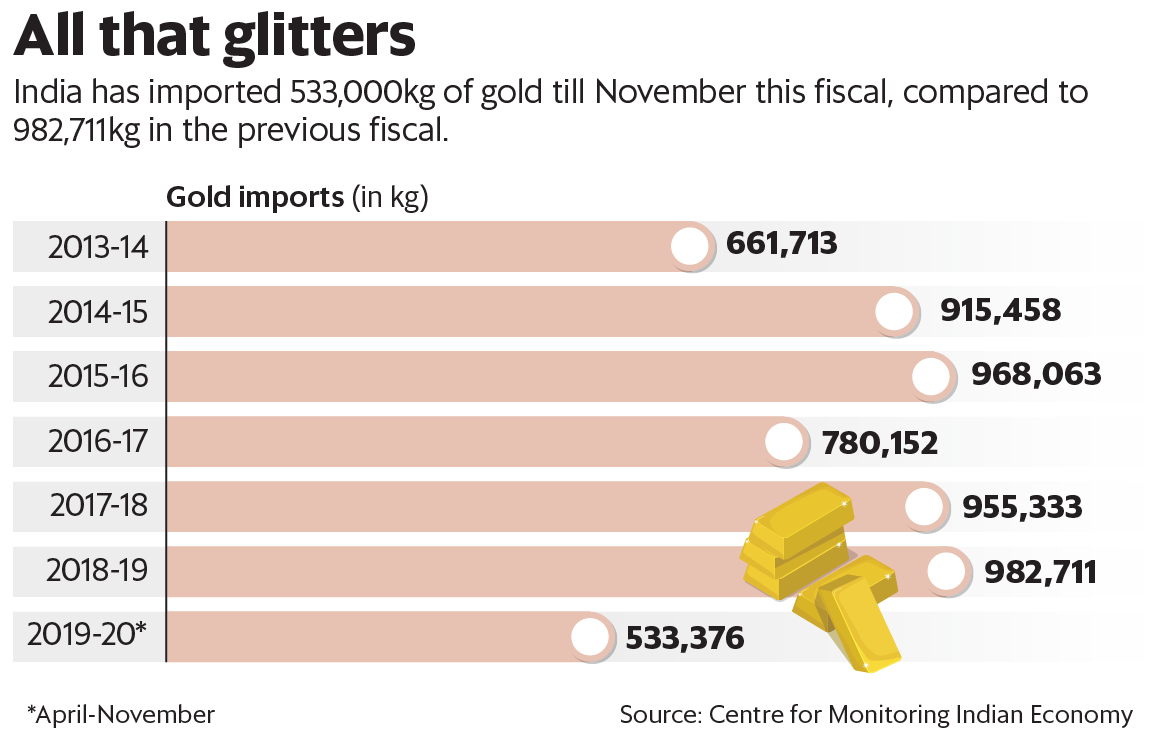◆ Indians diversify into gold coins, bars and jewellery because it never fails them in an emergency
◆ Indians are simply very prudent and practical and believe in channeling some of their wealth and saving into physical gold
◆ “A woman’s gold is both her personal treasure and plays a functional role as the family’s financial buffer” – Richard Davies
◆ Gold is an ‘obsession’ for very few people in the world today, including Indians, and most owners simply view it as a vital form of insurance in an uncertain world
| via Live Mint:
Mint takes a look at India’s love for gold The price of gold crossed ₹40,000 per 10g last week. Since the beginning of this fiscal, gold prices have surged by around 25%, driving down gold imports by a fifth during the same period. Mint takes a look at India’s love for gold. By how much have gold imports reduced? Between April and November, India imported 533,376kg of gold, around 20.3% less than 669,339kg imported during the same period in 2018. This is hardly surprising since gold has turned costlier this fiscal. Between April and November, the average price of gold was ₹35,337 per 10g, against ₹30,689 during the same period a year ago. Since November, prices have rallied higher due to Iran-US tensions. Over and above this, the easy money policy of the US Federal Reserve has made a comeback. The Fed has resumed printing money in order to drive down interest rates. This has pushed up gold prices as well. What explains the love Indians have for gold? Since very little gold is produced in India, almost all of the metal consumed is imported. Over the years, Indians have continued to love gold. In FY19, India imported 983,000kg of gold, the highest since FY14. A major reason for our love for gold remains tradition. But there is more to it than just that. As Richard Davies writes in Extreme Economies, “Gold also acts as a kind of informal insurance mechanism.” He writes this in the context of Aceh, a semi-autonomous province of Indonesia, and how survivors of the 2004 Asian tsunami rebuilt their lives using the gold they had on their bodies. How did gold help in the aftermath of the tsunami? As Davies writes: “While some lost gold in the disaster, I met many survivors who were able to sell jewellery they were wearing… Wearing a gold bangle is like having enough cash on your wrist to employ a builder for a year… This traditional form of finance insulated Aceh and provided its entrepreneurs with rapid access to cash.” How is this linked to India’s love for gold? Like in Aceh, India also has a very strong informal system of exchange where gold can be rapidly turned into cash, especially in times of emergency. As Davies writes again in the context of Aceh: “In an economy buffeted by the ups and downs of farming and fishing, the people are used to buying gold after bumper harvests or fishing seasons and selling it after lean ones.” This applies as much to India as it does to Aceh, with a bulk of the country’s workforce still dependent on agriculture for a living. What do economists make of this system? Economists, especially those working in the West, are used to banks and a formal financial system being in place and working well, even during emergencies. Buying and holding on to gold doesn’t fit into their way of doing things. But as Davies puts it, “A woman’s gold is both her personal treasure and plays a functional role as the family’s financial buffer.” That is the long and the short of India’s love for gold. Vivek Kaul is an economist and the author of the Easy Money trilogy. |
All That Glitters, 2013-2019 |
Full story here Are you the author? Previous post See more for Next post
Tags: Daily Market Update,newsletter






























